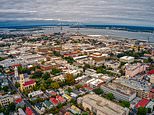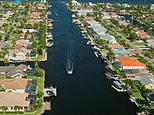
The iconic Fort Sumter, where the first shots of the American Civil War were fired, may have survived the famous 19th century battery, but experts warned it could now disappear under the waves outside Charlestown.
Nestled off the coast of South Carolina, this historic landmark – which once withstood a barrage of cannon fire – is crumbling in the face of destructive waves, fierce storms and rising sea levels.
‘It is one of the defining moments in our nation’s past,’ Dawn Davis of the National Park Service told Yale Climate Connections.
But the fort that is located outside the bay city is now among the fastest-sinking metros in the US, according to a concerning new study.
It is currently subsiding at an average rate of about 4 millimeters per year, which is equal to roughly an inch every six to seven years, Woodwell Climate reported.
In the following year, there is a 99 percent chance the city will experience flooding over two feet, it added.
Sea levels are projected to rise 1.21 ft by 2050 in Charleston and 2.46 ft by 2080, according to Woodwell Climate
The iconic Fort Sumter, where the first shots of the American Civil War played out, is now facing a relentless new battle – Mother Nature


A shot of Fort Sumter, April 1861, next to a photo of Fort Sumter’s damage after Tropical Storm
In the long-term, the rising water levels will provide even more catastrophic flooding to the quaint streets and avenues that make up the beautiful Southern metro.
Sea levels are projected to rise 1.21 ft by 2050 in Charleston and 2.46 ft by 2080, according to Woodwell Climate.
By 2050, northern parts of Charlestown’s French Quarter and south Harleston Village are predicted to be below the annual flood level.
By 2100, those waters are set to creep further inland, with more than half of the city being affected.
For Fort Sumter’s fate, Davis exposed the alarming extent of the erosion.
Walls are failing as waves crash into the historic structure, while large rocks meant to protect the site are now grinding against the fort’s original brick and mortar.
With sea levels continuously rising and storms growing more extreme by the day, the very foundation of American history is quite literally washing away before citizens’ eyes.
Pictured: The land projected to be below the annual flood level in 2050
Davis told Yale Climate Connections of the critical importance of preserving such historic sites for future generations.
‘These structures, these places, are the iconic reminders of where we’ve been,’ she says.
The fort was closed for nearly a month after being inundated with water in the wake of Tropical Storm Irma in 2017.
Davis was among the first to inspect the damage and painted a vivid picture of the aftermath.
The fort’s interior was flooded – forcing staff to wear tall boots to navigate the flooded areas.
‘The water had receded but not all the way,’ she told the Post Courier. ‘We definitely needed to wear tall boots to get around in places inside the fort.’
Nestled off the coast of South Carolina, this historic landmark – which once withstood a barrage of cannon fire – is now crumbling in the face of destructive waves and fierce storms (Pictured: Pictures of Fort Sumter’s damage after Tropical Storm Irma)
The fort is located in Charleston, which is among the fastest-sinking cities in the US – subsiding at an average rate of about 4 millimeters per year, which equals roughly an inch every six to seven years
Davis emphasized the critical importance of the tour boat dock, which serves as the gateway for thousands of visitors each year.
The railing and electrical lines of the boat dock were damaged, she revealed.
The storm’s surge had engulfed some of the historic cannons used to defend the fort, so they needed to be washed off, she told the outlet.
But Davis said the fort’s 19th-century structure, which withstood the opening of the Civil War, appeared to have emerged largely unscathed.
While the museum portion of the fort escaped unharmed, other modern amenities such as the public restrooms weren’t so lucky.
Davis admitted that the agency was feeling the strain as it juggled repair efforts across multiple national parks in Florida and Georgia.
With sea levels continuously rising and storms growing more extreme with the day, the very foundation of American history is quite literally washing away before our eyes
Despite the flooding risks, the historic Fort Sumter and Fort Moultrie National Historical Park have emerged as unexpected economic powerhouses – pumping a staggering $35.9 million into the local economy in 2023, according to a new report from the National Park Service.
Nearly 412,000 history buffs and curious travelers flocked to these iconic Civil War sites in that year alone.
‘When visitors come to visit their national parks, they’re not just visiting the National Park Service, they are visiting the local shops and restaurants that we have in the area,’ National Park Service’s Chief of Interpretation Brett Spaulding told Live5news.
Visitors spent a whopping $27 million in nearby communities, creating a financial ripple effect in the area.
This also led to a staggering 355 jobs in the local area.
‘Everybody benefits from this,’ he said. ‘Then word gets out as they return home, and we have new visitors coming in, which increases our visitation from year to year.’
The fort, which fell victim to Tropical Storm Irma’s fury in 2017, was closed for nearly a month after being inundated with water
But Davis said that the fort’s 19th-century structure, which withstood the opening of the Civil War, appears to have emerged largely unscathed
The storm’s surge had engulfed some of the historic cannons used to defend the fort, so they are ‘going to need to be washed off,’ Davis told the outlet
The fort’s interior was flooded – forcing staff to wear tall boots to navigate the flooded areas
‘Every year, the visitation has been increasing and impacting the local economies,’ Spaulding said.
‘I think it’s important that people come out to the park so that they can learn about their local history or national history, which were part of the Civil War and Revolutionary War,’ Spaulding said.
Earlier this month, Hurricane Debby ravaged the Carolinas and Georgia, with officials warning of unprecedented flooding as streets turned to rivers.
Charleston and Savannah were deluged, with Charleston imposing a curfew in its downtown peninsula that lasted 32 hours before it was lifted.
Dozens of roads were also closed due to flooding similar to what the city now sees several times a year because of rising sea levels.







